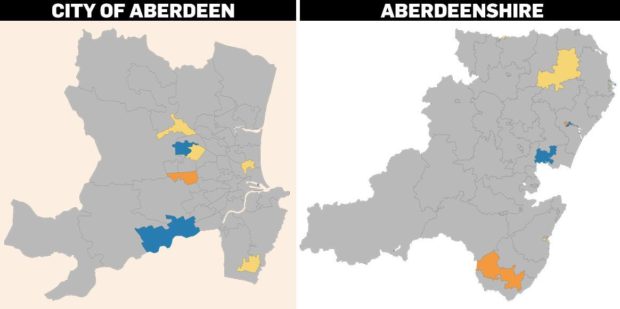Covid cases in the north-east have dropped by 54% in the past two weeks, new figures show.
Since January 9, the number of cases in the north-east has more than halved, from 1,320 to 616.
And the number of new coronavirus cases detected in the north-east in the past week has dropped by a further 34% compared to the previous seven-day period.
The latest data, released on Tuesday, shows 616 Covid-19 cases were detected in the north-east between January 17 and January 23, a drop of 34% compared to the previous figure of 929.
The biggest drop in cases has been seen in Aberdeen, with the region’s figures falling by more than a third (37.4%).
How is the positivity rate calculated?
Case numbers can be put into context by looking at them as a rate per 100,000 population.
This rate is then categorised into one of five bands by Public Health Scotland (PHS). If the number of cases in the seven-day period is two or less, it is marked as suppressed.
Each area of the country has been divided into regions of roughly similar populations, and are the same used in a wide range of national datasets released by the Scottish Government.
In the past day, there have been 87 new deaths registered, six of those were in the north-east – three in Aberdeenshire and two in the city and one in Moray – taking the country’s toll to 5,796.
A total of 174,002 people have now tested positive in Scotland, with 1,049 reported in the past 24 hours.
What’s the picture like Scotland wide?
The Scotland-wide seven-day positive rate per 100,000 population is 172.9, with 9,447 people testing positive during this period.
Of all the tests carried out, 8.1% of test returned a positive result.
The areas of the country with the highest positivity rate include Glasgow City, North Lanarkshire, Clackmanshire and Inverclyde. No local authority areas have a rate of more than 400 per 100,000.
Aberdeen
Aberdeen has an average rate per 100,000 population of 147.8 down from 236.1 during the previous seven-day period.
The figures show 338 positive cases of Covid-19 were identified during this period, a decrease of 37% (202) on the previous period.
Of all the tests carried out in the region, 7.5% were positive.
A map showing the breakdown of cases by neighbourhood reveals just one area in Aberdeen is in the highest category, with a rate greater than 400 per 100,000 people.
According to the figures, 37 Covid cases were detected in Danestone between January 17 and January 23, giving it a rate in excess of 900 cases per 100,000 people.
Of Aberdeen’s 49 zones, just nine have a rate of more than 200 cases per 100,000.
Nine areas of the city are in the lowest category, and six have their figures suppressed for the last seven days, meaning the number of case is between 0 and 2.
Lord Provost of Aberdeen Barney Crockett said: “We’re always very cautious about drawing conclusions but I think people in the north-east have been very disciplined in trying to do the right thing and we’re seeing the benefits of that in the drop in cases.
“We are all aware of the terrible implications this illness has for people and in order to keep the numbers declining, we will have to keep doing what we are doing and following the guidance.
“Well done to the people of the north-east for pulling together at this difficult time.
“I would encourage those in Danestone to keep following the rules and I’m sure we will see an improvement there in time.”
Aberdeenshire
In Aberdeenshire, there have been 278 cases in the last seven-day period, with a positive rate of 106.4 per 100,000 – below that of the Scottish average.
The test positivity rate for the region is at 5.8% for the latest seven-day period.
Only Stonehaven South is in the highest band after cases more than double from 15 in the data from January 10 to January 16, to 31 in the data released today.
This has given the neighbourhood a seven-day positive rate of 593.9 per 100,000.
Councillor Sarah Dickinson, who represents Stonehaven and Lower Deeside, said: “Any increase in cases is a pressing reminder that we must all continue to keep to the guidance.
“We can best take care of each other – our loved ones and our community – by staying home unless we have an essential reason to be out.
“My thoughts are with those who are ill and with our NHS staff who are responding with such fortitude under pressure.”
Elsewhere in the Aberdeenshire, just four areas are in the second-highest category, including two neighbourhoods in Fraserburgh.
More than half of the region has a rate below 100 cases per 100,000 people, with 16 areas having their data suppressed due to the number of cases falling between 0 and two.
